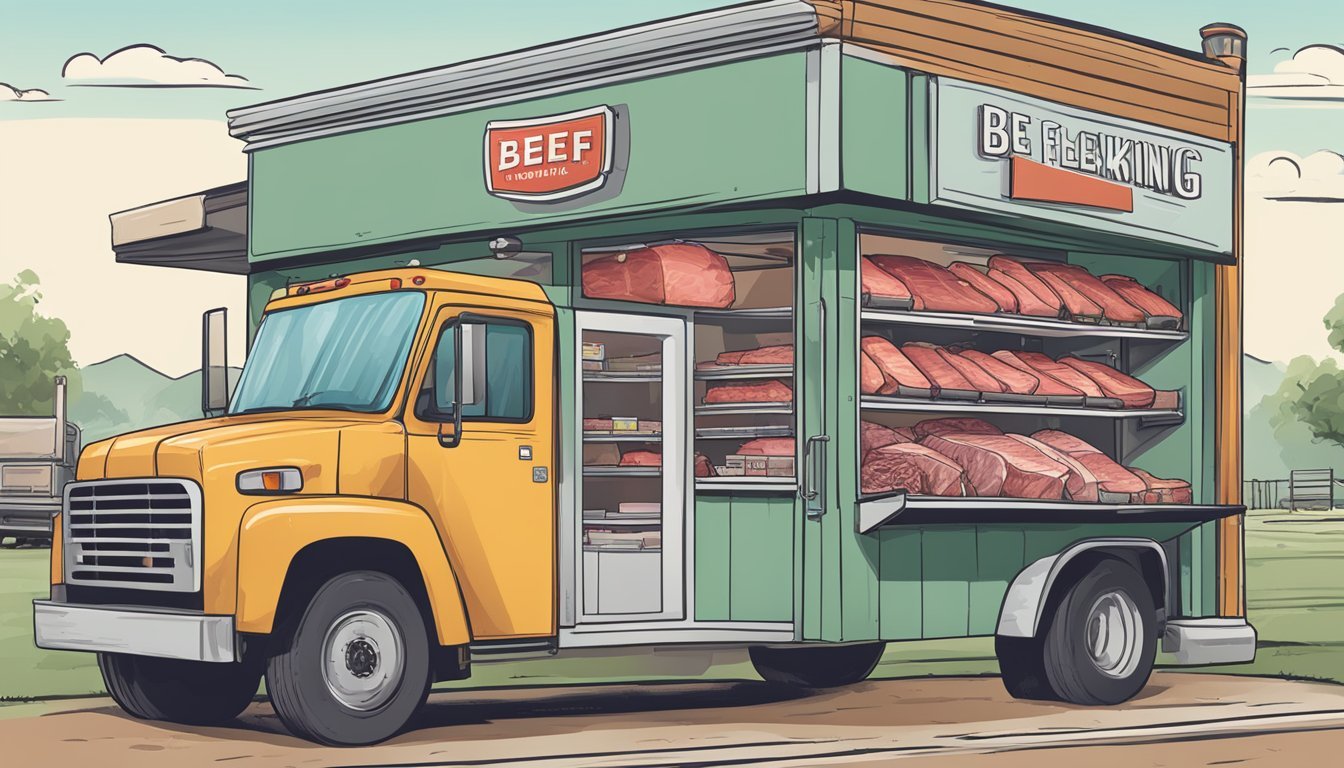What are the Considerations for Direct Marketing My Beef?
Key Strategies for Success
Direct marketing beef (What wine goes well with beef?) presents an opportunity for farmers and ranchers to tap into the ever-growing demand for locally sourced products. This approach enables producers within the beef industry to sell their products directly to consumers, bypassing conventional retail channels. By taking charge of their own marketing and sales, producers can potentially gain greater control over pricing, build customer relationships, and foster a deeper connection with local agriculture communities.
However, transitioning to a direct marketing strategy comes with its own set of challenges and considerations. Producers must evaluate factors such as target market identification, regulatory compliance, pricing strategies, and the logistics of processing and delivery. Understanding customer preferences and expectations is crucial for those looking to meet the demand for locally produced beef.
It is essential to have a clear marketing plan and knowledge of the resources required to execute direct sales effectively. Producers need to account for the additional time and labor involved in direct marketing, as well as the importance of maintaining the quality and safety of their beef products. The benefits of direct marketing can be substantive, but they require a strategic approach informed by careful planning and market research.
Understanding Direct Marketing
Direct marketing beef is an approach that allows producers to sell their products straight to the consumer. This method can enhance profitability through margin control but requires education on effective communication and understanding market demands.
The Basics of Direct Marketing
Direct marketing involves selling beef products directly to the end consumer, bypassing the traditional food supply chain. Producers can engage in this approach by utilizing various sales channels like farmers' markets, online sales, community-supported agriculture (CSA), or through farm shopfronts. An essential aspect to consider in this model is the comprehensive understanding of the regulations governing direct meat sales.
Advantages of Selling Direct
Selling beef directly to consumers offers a higher profit margin by eliminating the intermediaries. Producers build brand loyalty, tailor their products to meet customer preferences, and get immediate feedback. Communications are more personal, often leading to a deeper connection with the customer base. For example, engaging with the Agoro Carbon Alliance may offer added branding opportunities as environmentally conscious consumers may be drawn to beef produced with sustainable practices.
Challenges to Overcome
Despite the advantages, several challenges are associated with direct marketing. The most significant is the need for robust marketing strategies to attract and retain customers. Producers must invest in self-education about sales, marketing, and legal compliance. Moreover, supply chain logistics, such as processing and packaging, demand careful planning and resources. StringField(communication is also vital, as producers must often switch from the role of a farmer to a savvy salesperson, adept at navigating customer relations and expectations.
Regulatory Compliance and Documentation
To effectively direct market beef, it's crucial to navigate the intricate landscape of regulatory compliance and ensure proper documentation. The following subsections outline the specific requirements and considerations critical to the legality and success of direct beef marketing enterprises.
Meat Processing Regulations
When direct marketing beef, producers must utilize inspected facilities. The choices include federally inspected plants, which allow sales across state lines, or state-inspected facilities, which limit sales to within the state. All processing must abide by strict guidelines to ensure that meat is safe for consumption. These regulations cover everything from slaughter and packaging to labeling requirements.
Obtaining the Necessary Licenses
Before selling meat directly to consumers, there are several licenses and permits required. The exact requirements depend upon state law and the scale of operations, but generally include a retail meat license for selling packaged meat, and potentially additional permits for selling at farmers markets or other public venues.
Maintaining Accurate Records
Keeping accurate records is not only a legal obligation but also a business necessity. Detailed logs should include information on sales, expenses, inventory, and traceability. Moreover, all labeling must reflect the product accurately and comply with both federal and state labeling requirements to avoid misrepresentation and to ensure consumer confidence in your product.
Product Preparation and Quality
In direct marketing beef, attention to detail in product preparation and quality is critical. Producers must focus on carcass quality, neatly presenting individual cuts, and the role of genetics and feeding in the final product.
Ensuring High Carcass Quality
A high-quality carcass is paramount and is often measured by its marbling and fat thickness, which influence flavor and tenderness. A meticulous meat processing approach ensures the carcass integrity, optimizing the yield of lean muscle and maintaining supreme standards. Marbling should be sufficient to meet consumer expectations, while fat thickness should conform to industry specifications for the best quality and consumer satisfaction.
Meat Cuts and Packaging
The presentation of individual cuts is vital in direct marketing, where aesthetic appeal can drive consumer choice. Each cut should be trimmed skillfully, and the packaging must be secure and visually appealing, preserving freshness and extending shelf life. Vacuum-sealed packaging is a common method that ensures the longevity and quality of the meat as it transitions from farm to table.
Genetics and Feeding Programs
The genetic profile of livestock plays a critical role in meat quality, affecting traits such as marbling and overall carcass quality. Select breeding for genetic potential maximizes desirable characteristics. Coupled with a well-designed feeding program, which can significantly influence marbling and taste, producers can enhance the inherent quality of the beef. Consistency in feeding and management practices ensures that the genetic potential of the animals is fully expressed in the carcass.
Marketing and Sales Strategies
Effective marketing and sales strategies are critical for the success of any direct beef sales business. They focus not only on reaching new customers but also on creating a loyal customer base that continues to patronize your business due to the quality of your product and the efficiency of your service.
Developing a Strong Marketing Plan
A robust marketing plan lays the foundation for how your business will meet increasing consumer demand for direct-marketed beef. This plan should detail the specific strategies used to reach target audiences, including identifying the unique selling propositions of the beef. One must also consider the various components of cattle production and how they appeal to consumers, integrating this information into messaging that resonates with the target market.
Utilizing Social Media Platforms
Incorporating technology and social media platforms provides an expansive avenue to connect with consumers inexpensively and effectively. Establishing a Facebook page for your business can serve as a hub for engaging with customers, sharing information about your beef products, and building community. Regular updates with high-quality visuals and compelling content can help maintain visibility in a crowded online marketplace.
Creating Repeat Buyers
Ensuring that customers return is a key aspect of long-term success. Engage with them through personalized communication and, importantly, gather feedback to improve the buying experience. Repeat buyers are not only a stable source of revenue, but they can also become ambassadors for your brand, recommending your products within their networks, thus aligning with evolving consumer demand.
By leveraging these pivotal strategies—careful planning, social media engagement, and buyer retention—you can create a thriving direct market for your beef products.
Financial Management
In direct marketing beef, financial management is pivotal. One's ability to effectively manage finances can be the difference between a profitable venture and a failing one. The section focuses on pricing strategies, cost management, and profit analysis.
Pricing for Maximum Profit
Setting the right price is crucial in becoming a price setter rather than a price taker. Producers should understand that pricing must cover all costs while also providing a fair return on investment. A direct-to-consumer beef sales business can establish a value structure that reflects the quality and uniqueness of the product offered.
Managing Costs and Expenses
Properly managing costs involves understanding and controlling various expenses such as feed, labor, and especially processing charges. For instance, producers must work with processors who offer fair rates and transparent billing to avoid unforeseen costs that could eat into margins. Thoroughly documented expenses form the basis for informed financial decisions.
Analyzing Profit Margins
Analyzing profit margins requires a systematic examination of the relationship between selling price and incurred costs. Producers must track and evaluate financial data rigorously to ensure the business remains profitable. They should account for all variables, including market fluctuations and operational efficiencies, to optimize their profit margins.
Consumer Education and Relationships
In direct marketing beef, educating the customer on the various benefits and providing detailed health and nutrition information can foster strong customer relationships. Direct communication plays a pivotal role in enhancing the consumer's understanding and appreciation of the product.
Benefits of Buying Local Beef
Buying local beef offers customers numerous advantages. It supports local agriculture and bolsters the local economy. Consumers often find that local beef, especially when grass-fed, provides a fresher alternative to mass-produced meat. It also reduces the environmental impact by minimizing transportation.
Support for Local Farmers: Purchasers contribute directly to their local community's economy.
Freshness and Quality: Beef is typically fresher, potentially enhancing both flavor and nutritional value.
Health and Nutrition Information
When customers consider buying beef, health and nutrition are of paramount concern. Grass-fed beef is often leaner and contains higher levels of omega-3 fatty acids compared to grain-fed counterparts. Direct-to-consumer marketing can include sharing research-based facts on these topics to inform the consumers' decision-making process.
Leaner Protein: Grass-fed options may have less total fat, which can be beneficial for health-conscious customers.
Omega-3 Fatty Acids: A diet rich in these acids is linked to health benefits, such as improved heart health.
Direct Communication with Customers
Communication is essential in direct-to-consumer marketing. It allows farmers to directly answer concerns, share stories of sustainable farming practices, and build trust.
Transparency: By opening channels for questions and feedback, farmers exhibit transparency, boosting buyer confidence.
Education: Farmers can educate consumers on practices like rotational grazing, which can enhance the quality of beef while benefiting the environment.
Operational Logistics
When diving into direct marketing of beef, producers must strategically consider operational logistics to ensure efficiency and profitability. Coordinating processing schedules, managing inventory, and optimizing delivery and distribution processes are crucial steps for successfully selling direct-to-consumer beef, such as halves, quarters, and various cuts.
Coordinating Processing Schedules
Producers must work closely with butchers to schedule processing dates well in advance, accommodating the time required for each type of cut, from ground beef to roasts. Having a set schedule for processing allows for continuity and consistency, a critical aspect when offering freezer beef. It's important to track carcass weights and adjust accordingly to meet customer demand for specific cuts.
Inventory Management
Effective inventory management is key for maintaining a variety of cuts available at all times. Producers should have a system in place for tracking the quantity of popular cuts like ground beef and roasts, as well as less desirable cuts of meat. Inventory should be regularly reviewed and updated to align with sales trends, preventing overstocking or stockouts.
Delivery and Distribution
Developing a reliable system for delivery and distribution maximizes customer satisfaction and retention. Producers must determine if they will deliver directly to consumers or use third-party services. Freezer beef must be delivered in a way that preserves its quality, requiring appropriate transportation and storage solutions. Distributing effectively involves balancing customer proximity with cost-effectiveness.
Trends and Adjustments in Direct Marketing
The landscape of direct marketing for beef is continually evolving, shaped by technological advancements, shifts in consumer preferences, and global occurrences like food shortages and pandemics.
Impact of Technology on Direct Sales
Technology has revolutionized direct marketing, offering niche markets unprecedented access to premium beef products. Innovations such as variable data printing allow for highly personalized marketing materials, catering to individual consumer preferences and increasing the perceived value of the products.
Adaptation to Market Changes and Consumer Trends
Direct marketers must remain agile, adjusting strategies in response to market changes and consumer trends. This includes recognizing a shift towards organic and grass-fed beef among health-conscious consumers and adapting marketing efforts to highlight these premium options in their inventory.
Responding to Global Events and Food Shortages
The pandemic highlighted the importance of responsive marketing strategies. Direct marketers successfully navigating food shortages leveraged real-time analytics to adjust campaigns, ensuring continued access to beef products while addressing consumers' heightened concerns about food security.
Conclusion
In the landscape of beef sales, transitioning to direct-to-consumer marketing demands careful consideration. While such ventures can empower producers to become price setters, they simultaneously necessitate meticulous business planning and record-keeping. Producers must evaluate if their operation can handle the regulatory demands and the additional time investment required.
Farmers looking to embrace direct marketing should develop targeted strategies to reach their desired customer base effectively. This may include exploring outlets like local farmers markets or online platforms. It's critical to establish a strong brand identity and understand customer preferences to ensure product offerings align with market demands.
They should consider the following key points in their business plan:
Inspection Requirements: Ensure compliance with slaughter facility inspection laws.
Customer Engagement: Maintain clear and frequent communication with customers.
Carcass Utilization: Plan use of the entire carcass to maximize returns.
Marketing Strategies: Develop branding and invest in quality packaging.
As they navigate direct marketing endeavors, producers must stay grounded in the realities of the market and adjust their plans accordingly. By adhering to these tenets, they position themselves to capitalize on the direct marketing opportunity while serving consumers who value locally-sourced beef.






